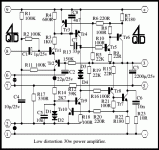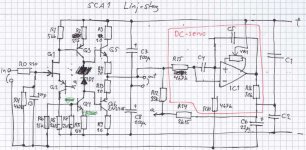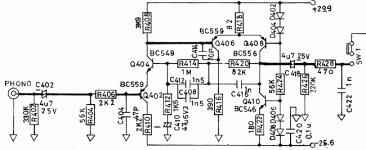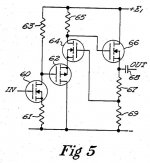forr said:By connecting two transistors by their emitter, you can make a differential pair.
If they are of the same polarity, and the emitters see a (preferably high) resistance or a constant current source, you've got a long tail pair : it's a parallel differential pair.
If the transistors are of opposite polarity, you've got a series differential pair. One gets rid of he constant current source. I think it's sometimes called a Rush amplifier. It is interesting because it has gain without inverting.
In his famous paper in Wireless World 1977, Taylor gives the following distorsion figures :
1% for each mV at the input of a single bipolar
and thirty times less for a parallel differential pair with a 5% current mismatch.
However an overlooked problem with a differentail pair is that its distorsion components, albeit low, are depending on its DC equilibrum which continuously change in an amlifier to correct the output offset.
Is that audible ?
The distorsion components of a single transistor probably behave in a more constant manner. And amplifiers using a single active device at the input have a more simple HF behaviour.
Some people think it would be a good idea to go back to the capacitively coupled output of input stage of amplifiers (as used in tube amps) to avoid its depedance of the DC condition of the whole amplifier.
~~~~~~~ Forr
§§§
I also saw this connection, called the rush cascode. I think there's one in a naim preamp or phono amp
However an overlooked problem with a differentail pair is that its distorsion components, albeit low, are depending on its DC equilibrum which continuously change in an amlifier to correct the output offset.
I also think the same thing, the VBE value in the junction of LTP is not steady at all, it follows the mix of left and right transistor Ibias. This constant change maybe small, but audible. And in a differential (parrarel one), this VBE inhibits harmonic, I imagine it happens like in post #1.
Maybe we can know why "not-ordinary" topology, like the JLH classA or F2 sounds good
> the best thing to do is to use self-linearising, distortion-cancelling circuits.
I used to think that.
You did notice, I hope, that there is only local feedback, and lots of local degeneration where a nonlinear node addects the gain function. Also the degeneration is in proportion to the user-set gain, or in other words the output linearity does not change with gain.
I think the quote attributed here to Bob Pease is on the point:
Just remember: in theory there's no difference between theory and practice.
But in practice it usually is quite a bit difference...
Getting all these complicated "cancellation" systems to actually cancel is not easy. Part of the problem is that identical devices never match exactly. A partial fix for that is Integrated Circuits, but they have such a bad reputation that we keep them isolated in their own forum section.
> here's the debate
I'm not going to read all that tonight; but it starts off about cascodes.
The basic plan I posted is not a cascode, as the word "cascode" is normally used.
The complicated version has aspects of cascoding but is really something else.
> if I'd like to have <0.1% THD
"THD" is NOT a useful criteria for speech/music amplifiers.
I followed the whole decline of the state of the art from 1% to past 0.01%. "Decline" in number and often a decline in sound quality. Unless you are comparing very similar amplifiers (which will IAC have roughly similar THD numbers), the "total" is meaningless. If you must have a single-number for a complicated mix, at least "weight" the partials according to masking potential and harmonicity.
I used to think that.
You did notice, I hope, that there is only local feedback, and lots of local degeneration where a nonlinear node addects the gain function. Also the degeneration is in proportion to the user-set gain, or in other words the output linearity does not change with gain.
I think the quote attributed here to Bob Pease is on the point:
Just remember: in theory there's no difference between theory and practice.
But in practice it usually is quite a bit difference...
Getting all these complicated "cancellation" systems to actually cancel is not easy. Part of the problem is that identical devices never match exactly. A partial fix for that is Integrated Circuits, but they have such a bad reputation that we keep them isolated in their own forum section.
> here's the debate
I'm not going to read all that tonight; but it starts off about cascodes.
The basic plan I posted is not a cascode, as the word "cascode" is normally used.
The complicated version has aspects of cascoding but is really something else.
> if I'd like to have <0.1% THD
"THD" is NOT a useful criteria for speech/music amplifiers.
I followed the whole decline of the state of the art from 1% to past 0.01%. "Decline" in number and often a decline in sound quality. Unless you are comparing very similar amplifiers (which will IAC have roughly similar THD numbers), the "total" is meaningless. If you must have a single-number for a complicated mix, at least "weight" the partials according to masking potential and harmonicity.
- Status
- This old topic is closed. If you want to reopen this topic, contact a moderator using the "Report Post" button.
- Home
- Amplifiers
- Solid State
- Input stage idea



